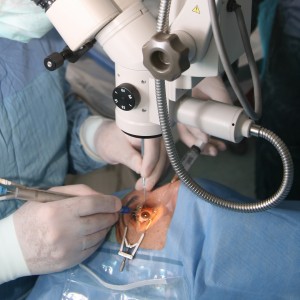 Dr. Richard L. Lindstrom from Minnesota Eye Consultants and Adjunct Professor Emeritus at the University of Minnesota recently wrote an opinion article concerning ophthalmic cataract surgery simultaneously in both eyes. The article is entitled “Bilateral same-day sequential cataract surgery will eventually become commonplace” and was published online in the Ocular Surgery News U.S. Edition.
Dr. Richard L. Lindstrom from Minnesota Eye Consultants and Adjunct Professor Emeritus at the University of Minnesota recently wrote an opinion article concerning ophthalmic cataract surgery simultaneously in both eyes. The article is entitled “Bilateral same-day sequential cataract surgery will eventually become commonplace” and was published online in the Ocular Surgery News U.S. Edition.
Bilateral sequential procedures are routinely performed in the same day by ophthalmic surgeons. This is especially true for conditions such as strabismus surgery (to correct the misalignment of the eyes), oculoplastic surgery, and laser corneal refractive surgery (like photo refractive keratectomy – PRK, and laser-assisted-in-situ keratomileusis – LASIK). “We do these procedures when we, as individual surgeons, believe they are in our patients’ best interest and the benefits outweigh the risks,” explained Dr. Lindstrom.
“Years ago, it was extremely controversial to perform bilateral same-day sequential LASIK,” said Dr. Lindstrom. Since then, several groups have conducted trials to compare same-day bilateral surgery to 1 week or 1 month apart surgery in terms of visual outcomes, possible complications and overall patient satisfaction. Researchers concluded that patient satisfaction was considerably higher in patients who underwent same-day bilateral sequential surgery, while there was no risk benefit in waiting for surgery between the eyes.
The main argument against same-day bilateral surgery is the possibility of a sight-threatening infection, an extremely rare event that was estimated to occur in around one per 25 million patients (one in 5,000 per eye). Dr. Lindstrom prefers bilateral same-day sequential LASIK procedures, although he offers patients the option of treating one eye at a time. “Less than 1% of patients in my practice choose this option, and (…) in 25 years of doing well more than 60,000 eyes, we have never encountered a bilateral infection in our practice.” In fact, the majority of ophthalmic surgeons worldwide agree that bilateral same-day sequential LASIK is a justified procedure and a proper option for the patient.
The same issue has now been raised regarding intraocular procedure and cataract surgery. With the current antiseptics and antibiotics available, the infection rate in cataract surgery is almost around one per 5,000 patients, similar to the numbers of LASIK surgery. The decision on the best approach should be made by the surgeon and the patient, bearing in mind the patient’s best interest. “Patients are definitely open to this option because it is convenient with less time commitment by the patient and their family or friends who assist in the process. The resistance comes mainly from ophthalmic surgeons, who generally counsel against it. In addition, in many countries, including the U.S., there are reimbursement barriers that penalize the surgeon who takes this approach.”
Dr. Lindstrom is not offering bilateral same-day sequential cataract surgery yet to his regular patients “partly because of the reimbursement barriers, partly because of tradition, partly because of the potential medicolegal risks and partly because I am still struggling with the decision.” However, the surgeon believes that in order to provide high-quality care, obtain high patient satisfaction, and achieve these goals at a lower cost, innovative approaches like bilateral same-day sequential cataract surgery are required.
“Of course, every patient should be given the option of surgery on their two eyes separated by any length of time they prefer, but my crystal ball tells me that in the lifetime of the cataract surgeon being trained today, bilateral same-day sequential cataract surgery will be routine. As always, surgeon judgment will be critical in selecting appropriate patients, and any significant intraoperative complication in the first eye will lead to aborting the second eye surgery,” concluded Dr. Lindstrom.


